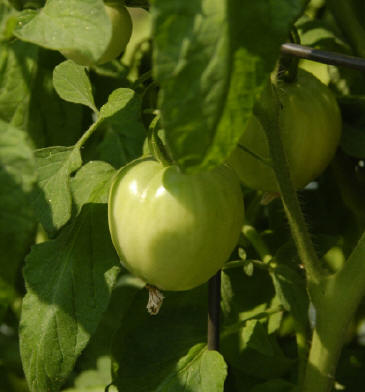|
Tomato Plants Dry? No problem!
Lee Royer
Frederick County Master Gardener
 Tired of lugging gallons of water to the garden or paying extra on your water bill? Hear the good news about dry-farming
tomatoes. Tired of lugging gallons of water to the garden or paying extra on your water bill? Hear the good news about dry-farming
tomatoes.
For the past decade enterprising Santa Cruz, CA, small farmers have been growing better tasting tomatoes using less water with a method called dry-farming. Their reputation for the most
flavorful tomato has been growing and they have almost a mystical, cult-like following among San Francisco Bay area farmer’s market patrons and chefs in the region. Alice Waters, famous foodie and restaurateur of Chez
Pannisse, was quoted by an interviewer as saying "One of the best tomatoes I’ve ever had was an "Early Girl" that was dry farmed up in Napa at a friend’s house".
Here’s how
Choose a young, sturdy hybrid tomato transplant with a short growing cycle, such as "Early Girl". Gently strip it of all leaves below the top set of four or six. Plant it deep, so only those
few leaves are showing above ground. Irrigate only the first week after transplanting, or if the weather is extremely dry, water until the first blossoms appear. In a normal Maryland year we would mulch with straw but this
year it’s possible to mulch as true dry-farmers do, with dust mulch. With a hoe, bust up the top soil to create a layer of dust, preventing underlying water from escaping, just as other mulches do. Let nature do the watering
and harvest some of the tastiest tomatoes ever.
 Hybrid vigor helpful Hybrid vigor helpful
Why do dry-farmers use "Early Girl" or similar hybrids when heirloom varieties have been shown to be so popular in taste tests? "Early Girl" has proven to be very adaptable to dry-farming
because it is proficient at quickly developing a deep root system which then seeks out exiting ground water. It is a short growing season tomato (50 days to maturity) with hybrid vigor, resistant to verticillium and fusarium
wilt. It is reliable and prolific. Many heirlooms lack these traits.
Research
University of California Extension Advisor for Small Farms and Specialty Crops, Aziz Baameur of Santa Clara County, began conducting studies in hopes of discovering the reason for the claims
of extraordinary flavor from such ordinary tomatoes as the lowly hybrid, "Early Girl".
Aziz planted five experimental plots of tomatoes. Then he tracked them using a network of weather stations called the California Irrigation Management Information System (CIMIS), developed to
help farmers irrigate efficiently. In each plot "Early Girl" transplants eight weeks of age were watered only for the first week after planting in May, and then the water regiments diverged. His five test plots were watered
according to CIMIS recommendations at five levels, 0%, 25%, 50%, 75%, and 100% irrigation.
Laboratory results showed tomatoes in the less watered plots of 0%, 25%, and 50%, had higher sugar, soluble solids, and lycopene (an antioxidant responsible for red color). Blind taste
testers choose those as the tastiest tomatoes, as well. Tomatoes irrigated to the 75% and 100% levels were judged less flavorful and the only ones with tough skins.
Cost of great taste
Every method has drawbacks as well as rewards, with dry-farming tomatoes the drawbacks are slightly lower yields, smaller fruit, and increased chance of blossom-end rot. Farmer’s market
producers know quality (taste) is more important than quantity (high yields). One producer put it this way, "customers come to me for the best tasting tomatoes, not because I can produce tons per acre". Another said she
knows dry-farming may reduce her yields, but chooses to grow more plants rather than grow more fruits per plant that don’t have the best flavor possible.
Blossom-end rot is a common nutritional tomato disorder caused by calcium deficiency. Lack of water is often cited as a contributing factor because water is needed to move the calcium
throughout the tissues of developing fruit. Symptoms begin with a brown discoloring at the blossom end which eventually grows, flattens and shrinks inward. Secondary organisms such as fungi often invade, causing soft rot or
moldy spots. However, water issues are not alone in encouraging blossom-end rot. Low soil pH and excessive use of nitrogen fertilizers are sometimes to blame. Always begin gardening with a current (within 3 years) soil test
and follow recommendations for fertilizing properly.
One last thing about tasty tomatoes, dry farmed or not - don’t refrigerate uncut tomatoes. Refrigeration dehydrates flavor out, which is partly why grocery tomatoes have such a bad
reputation. Most are refrigerated until they reach the store, only then correctly displayed at room temperature, but the damage has been done. Once you cut them, refrigeration is necessary to prevent rapid spoiling.
Read other articles on growing herbs or vegetables
Read other recipes
from the garden Read other articles by Lee Royer
|